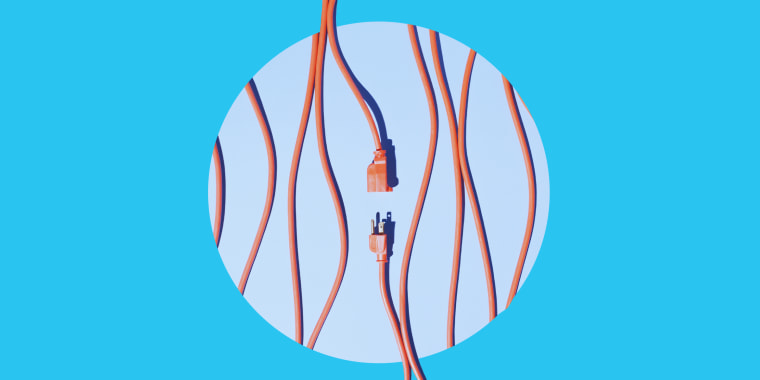With many states experiencing record-breaking heat waves, air conditioners are running full throttle to keep homes cool. Summer is already the season when homeowners see upticks in their energy bills, and now with the coronavirus pandemic, more people are home for much of the day.
The typical household spends roughly $2,000 annually on energy bills, an Environmental Protection Agency spokesperson told TODAY. The EPA added that in the summer months, air conditioning is the likely culprit for energy bill increases. Nearly half of a given home’s total energy bill is dedicated to heating and cooling systems.
For those living in cities, it is projected that homeowners could see monthly energy bills rise by 10% based on data collected from renewable energy company Arcadia. Data was collected from energy use by 10,000 customer households across 13 major U.S. cities during March and April.
To make matters worse, Tropical Storm Isaias left more than 6.4 million people without power from South Carolina to Maine last week, according to Poweroutage.us, a website that collects power outage data from utilities across the country. And nearly 200,000 customers in the Northeast are still without power six days after the storm hit the region.
If you're looking to keep electricity bills down as temperatures soar, try these short- and long-term recommendations from the EPA and other sources.
Check your air filters every month
The EPA offers numerous energy-saving suggestions, with the majority aimed at maximizing air conditioners. One of the easiest steps you can take involves checking air filters every month.
“At a minimum, change the filter every three months,” a spokesperson for the EPA said in an email to TODAY. “A dirty filter will slow down airflow and make the system work harder to keep you warm or cool — wasting energy.”
Maintaining a clean filter will also prevent dust and dirt buildup, which can cause system failures over time. Another simple solution? Close window shades and drapes to block out the sun’s rays.
Use ceiling fans the right way
The EPA wants to remind people that ceiling fans cool the occupants in a room, not the room itself. This means that you should turn it off whenever leaving a room. Raising your thermostat by 2 degrees in conjunction with a ceiling fan can lower air conditioning costs by up to 14%.
Beware the 'phantom loads'
After a late night Netflix binge, what do most people do when they are heading to bed? They plug in their phone and let it charge until morning. Not only can this practice weaken a device’s battery over time, but this could be a likely source for why your electricity bill is on the rise. The Office of Energy Efficiency & Renewable Energy defines these as appliances that draw energy when plugged in but not in use.
Energy Sage adds that voice-activated devices or those in “stand by mode” are common drains on electricity. Printers, computer monitors, cable boxes, video games systems and other entertainment systems are common culprits that can cause a significant spike in your electricity bill.
A quick solution is to determine what devices are energy sucks in passive states. From there, plugging the biggest culprits into a smart strip, surge protector strip, or power bar will greatly help. In doing so, you can effectively power down the surge protector at night or when not in use, effectively reducing the number of daily “phantom loads.”
Look for the Energy Star stamp of approval on products
Energy Star is the EPA and U.S. Department of Energy’s program that designates products as being “energy efficient.” The EPA reported that a household outfitted with Energy Star-certified appliances and systems will use 30% less energy and “avoid more than 5,500 pounds in greenhouse gas emissions per year.” The EPA wrote that even switching from incandescent light bulbs to Energy Star certified LEDs produces 70% to 90% less heat and can cut costs linked with home cooling.
Also, ensuring that your home is outfitted with windows that reduce interior heat gain can help the baseline temperature of your home, thereby somewhat reducing the need for air conditioning.
Seal your home’s ducts
The EPA reported that both sealing and insulating ducts can improve heating and cooling efficiency by more than 20%. It suggests focusing on sealing ducts running through the attic, basement or garage, and follow up with insulation to keep them from getting too hot or cold. Insulation greatly aids in maintaining ideal temperatures regardless of the season.
Make some changes in the laundry room
Washers and dryers are commonly some of the most expensive appliances to operate, according to the DOE. It recommends using cold water on clothes whenever possible. Even washing with warm instead of hot can have dramatic effects on your annual bill. Cold-water detergents exist and are marked by the high efficiency “HE” seal on bottles.
When it comes to dryers, consider letting clothes air-dry on clotheslines or using a lower heat setting to reduce the likelihood of overdrying clothes.
And adjusting dryer settings can play a big role. Newer dryers now come equipped with a “moisture sensor” option that will automatically stop a load if it detects that clothes are dry before the load time expires. Meanwhile, the cool-down cycle enables clothes to dry via the heat still in the dryer.
Doing laundry overnight also has its perks. Some utility companies offer lower energy costs at night, although you should contact your own company to confirm.
Retool your refrigerator
Reducing energy levels on an appliance that is constantly running can lead to big payoffs on your bills.
Regularly cleaning the condenser coils at the rear of the fridge prevents this appliance from working too hard. The website The Spruce recommends cleaning coils once every three months for maximum performance.
As an added measure, keeping a fridge or freezer full insulates them, lessening the amount of time they have to run to remain cold. And when putting food in the fridge, it is recommended that you should cool food before placing it in the fridge to keep a fridge from having to work harder to maintain ideal temperatures.
For those with a secondary fridge in the garage, consider moving it to the basement. Since garages are typically exposed to extreme weather changes, it will cause your refrigerator to work harder to keep foods cold, according to The Spruce.
Plan ahead
The EPA suggests researching more eco-friendly replacements for big purchases like a water heater before problems arise. Water heaters account for 12% of a home’s energy consumption, and a more energy-conscious water heater can save households almost $330 annually. If your water heater or heating, ventilating, and air conditioning system is 12 years or older and needs frequent repairs, chances are you should invest in a new system.
HVAC systems account for $900 in energy bills a year for the average household, according to the EPA, so scheduling maintenance checks is an important part of maximizing efficiency. HVAC contractors will inspect heating and cooling equipment and will also likely clean various components.
Look into utility bill assistance programs
If you simply cannot afford to pay off your energy bills during the coronavirus pandemic, there are programs to allay the costs.
Check out customer programs through energy providers like Duke Energy. California-based Pacific Gas & Energy offers a one-time payment assistance program to help people through hard times by scheduling payment of your current balance over a few months.
The Low Income Home Energy Assistance Program is a federal program that helps qualifying low-income families pay off their energy bills. A four-person family qualifies if their annual household income is less than $39,300 before taxes. Another program for low-income families is Relief for Energy Assistance through Community Help, which helps customers who have fallen into unforeseen hardships.
Still another option is a prepaid electricity plan. Programs like these offered by AP Gas & Electric in Texas prevent homeowners from going beyond their means and using more electricity than they can afford.


